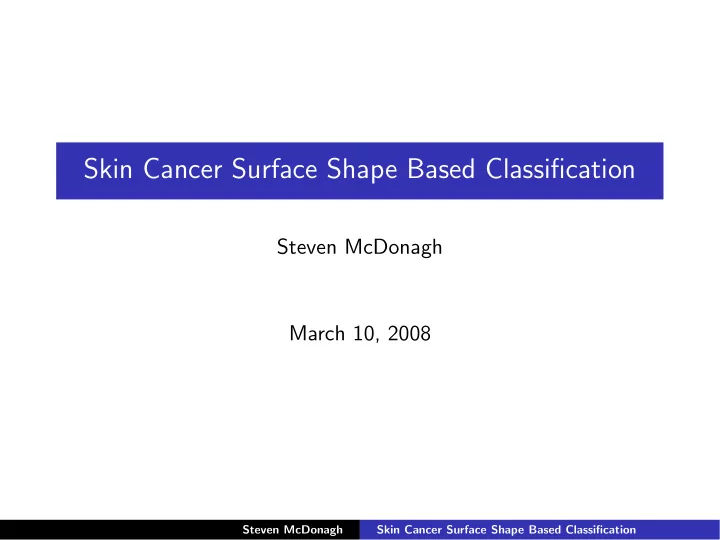

Skin Cancer Surface Shape Based Classification Steven McDonagh March 10, 2008 Steven McDonagh Skin Cancer Surface Shape Based Classification
Motivation ◮ A non-trivial classification problem ◮ Clinician’s time is valuable ◮ Good track record if caught early enough Steven McDonagh Skin Cancer Surface Shape Based Classification
Hypothesis A classification system using a combination of standard and depth based image features is more successful at the task of classifying skin lesion images than a system which uses standard image features alone. Steven McDonagh Skin Cancer Surface Shape Based Classification
The system Steven McDonagh Skin Cancer Surface Shape Based Classification
The system ◮ Data capture and pre-processing ◮ Feature calculation and selection ◮ Training and classification Steven McDonagh Skin Cancer Surface Shape Based Classification
Data capture Figure: Stereo-scopic geometry Figure: Stereo camera rig Steven McDonagh Skin Cancer Surface Shape Based Classification
Data capture Figure: Lesion colour data Figure: Lesion reconstruction from range data Steven McDonagh Skin Cancer Surface Shape Based Classification
Pre-processing Figure: Sample 2 Figure: Sample 1 Steven McDonagh Skin Cancer Surface Shape Based Classification
Pre-processing Figure: Sample 2 Figure: Sample 1 Steven McDonagh Skin Cancer Surface Shape Based Classification
Pre-processing ◮ Image Segmentation: Separate lesion from surrounding skin ◮ Automated thresholding techniques ◮ Do it manually! Figure: Hand segmented image Steven McDonagh Skin Cancer Surface Shape Based Classification
The system ◮ Data capture and pre-processing ◮ Feature calculation and selection ◮ Training and classification Steven McDonagh Skin Cancer Surface Shape Based Classification
Feature calculation ◮ What is a feature? ◮ Standard 2D image based features ◮ A symmetry ◮ B order irregularity ◮ C olour variegation ◮ D iameter Figure: Sample features feature vector X = [ − 2 . 42 , 412 , 0 . 63 , 50 . 75] Steven McDonagh Skin Cancer Surface Shape Based Classification
3D features ◮ ∆ spotheight (avg spot z depth − avg skin z depth) Figure: ∆ spotheight σ [ z ] ◮ R z = spot local texture σ [ z ] skin roughness ratio ◮ Peak and pit density # peaks + # pits spot area Steven McDonagh Skin Cancer Surface Shape Based Classification
Investigating a feature ∆ spotheight Figure: 1D Scatter plot for i1 feature Steven McDonagh Skin Cancer Surface Shape Based Classification
Investigating a feature ∆ spotheight Figure: Scatter plot for i1 feature Steven McDonagh Skin Cancer Surface Shape Based Classification
Feature selection ◮ n features? ⇒ 2 n subset combinations! ◮ How do we select the best feature subset? ◮ Feature subset selection ◮ Sieve out the irrelevant / redundant features ◮ Goal : Small subset of features that give high predictive accuracy ◮ For any given image we can now compute a feature vector X = [ f 1 , f 2 , ..., f m ] m ≤ n Steven McDonagh Skin Cancer Surface Shape Based Classification
Figure: Evolution of subset classification accuracy Steven McDonagh Skin Cancer Surface Shape Based Classification
The system ◮ Data capture and pre-processing ◮ Feature calculation and selection ◮ Training and classification Steven McDonagh Skin Cancer Surface Shape Based Classification
Training and classification ◮ Goal : Given a previously unseen lesion image X ⇒ compute the most likely class k that it belongs to ◮ k ∈ { Basel cell carcinoma, Squamous cell carcinoma, Seborrheic keratosis, Melanocytic naevus, Actinic keratosis } ◮ We need to find P ( class = k | X ) for each class k ◮ Classify new image data X as: 1. Class k which provides highest conditional probability 2. Assign sample X to the class j which minimises the quantity Σ k L kj P ( class = k | X ) Steven McDonagh Skin Cancer Surface Shape Based Classification
Experimental results Diagnosis AK BCC ML SCC SK AK 11 0 0 0 0 100% BCC 0 57 1 4 3 87.6% True ML 0 4 48 2 7 78.6% SCC 0 4 1 19 1 76% SK 0 4 8 5 55 76.3% Overall accuracy 83.7% Misclassification cost 196 Table: Best feature set found by accuracy based criterion Steven McDonagh Skin Cancer Surface Shape Based Classification
Experimental results Diagnosis AK BCC ML SCC SK AK 11 0 0 0 0 100% BCC 0 47 3 14 1 72.3% True ML 0 4 48 4 5 78.6% SCC 0 0 1 23 1 92% SK 0 6 15 5 46 63.8% Overall accuracy 81.3% Misclassification cost 183 Table: Best feature set found by cost based criterion Steven McDonagh Skin Cancer Surface Shape Based Classification
Experimental results Diagnosis AK BCC ML SCC SK AK 11 0 0 0 0 100% BCC 0 55 3 2 5 84.6% True ML 0 7 49 0 5 80.3% SCC 0 9 2 11 3 44% SK 0 7 8 1 56 77.7% Overall accuracy 77.3% Misclassification cost 306 Table: Best feature set found when constrained to colour feature pool Steven McDonagh Skin Cancer Surface Shape Based Classification
Discussion ◮ Novel data capture techniques may provide us with useful information ◮ Feature calculation and selection methods are just as important as data quality ◮ Success measure is vital! Steven McDonagh Skin Cancer Surface Shape Based Classification
Thanks for listening! ◮ Questions? Steven McDonagh Skin Cancer Surface Shape Based Classification
Recommend
More recommend